Forget Fillings: New Study Shows How to Regrow Teeth

Share
Few of us are graced with a perfect mouthful of teeth. If it’s not braces or cavities, it’s wisdom teeth or root canals. Adding injury to insult, while medicine has made a lot of progress in multiple fields over the years, dentistry has remained stubbornly stuck to the same painful, outdated techniques.
I was lucky enough not to need braces as a kid, but a persistent sugar addiction meant every time I visited the dentist I had at least one cavity. To this day, I can’t hear the sound of a drill—or even think about going to the dentist—without cringing.
A study published in Scientific Reports last week may be good news for fellow dentist-fearers. The study details the success of trials in which a stem cell treatment was used to repair tooth decay in mice.

Tooth repair after four weeks (left) and six weeks (right). Image Credit: Kings College/Scientific Reports
Normally, when our teeth get cavities the dentist clears out the decayed material then fills in the empty space with one of various materials, including porcelain, silver amalgam, or composite resin. These fillings work well enough, but after a few years they typically need to be replaced, and can end up weakening teeth to the point that they need to be extracted.
What if teeth could instead repair themselves, independently regenerating decayed material?
To some extent, teeth already do this. When the inner pulp of a tooth is exposed, mesenchymal stem cells—which can differentiate to become cartilage, bone or fat cells—mobilize to form tooth-specific cells called odontoblasts. These secrete dentine, a reparative substance that seals off the tooth pulp from the external environment.
This natural process is enough to repair minor fissures below the tooth’s surface enamel, but doesn’t cut it when it comes to cavities. The new treatment involves accelerating the tooth’s natural dentine production to repair larger defects.
Scientists found that tideglusib, a drug typically used to treat neurological conditions like Alzheimer’s and autism, can be used to stimulate stem cell differentiation in the tooth’s pulp. These create more odontoblasts, which create more dentine.
In the study, scientists inserted a biodegradable collagen sponge soaked in tideglusib into mice’s teeth, then sealed the teeth with a dental adhesive. Over the course of a few weeks, the sponges degraded and were replaced by newly-produced dentine.
Be Part of the Future
Sign up to receive top stories about groundbreaking technologies and visionary thinkers from SingularityHub.


So the good news is, signs point to teeth being able to repair themselves, no need for artificial fillings.
The bad news is, a dentist would still need to use a drill to get rid of the decayed part of a tooth. Dentist-fearers could take some comfort, though, in knowing the process would be a one-time thing, with no need for filling replacement or tooth extraction down the road.
Scientists are currently moving to testing the procedure in rats, whose teeth are bigger than those of mice. If successful, human trials could start later this year.
It’s possible our teeth are too big for the treatment to work. Mouse teeth are much smaller than ours, so the spaces filled by the stem cell treatment were significantly smaller too.
If the treatment does work in humans, I’ll be one of many people grateful to know that my visits to the dentist’s chair could soon be fewer and farther between.
Banner Image Credit: Shutterstock
Vanessa has been writing about science and technology for eight years and was senior editor at SingularityHub. She's interested in biotechnology and genetic engineering, the nitty-gritty of the renewable energy transition, the roles technology and science play in geopolitics and international development, and countless other topics.
Related Articles

This Week’s Awesome Tech Stories From Around the Web (Through December 20)

Data Centers in Space: Will 2027 Really Be the Year AI Goes to Orbit?

New Gene Drive Stops the Spread of Malaria—Without Killing Any Mosquitoes
What we’re reading